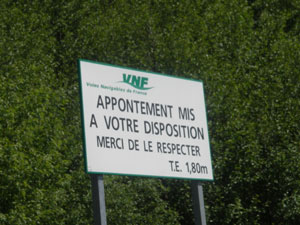|
|
| From Paris to Avignon | |
|
After six fantastic months in Paris we were now ready to leave. The leg to Avignon has been full of experiences and new knowledge acquired. The Canal de Bourgogne, with its´ 189 locks, wasn´t as bad as we thought. Our guide book states that boats with a draught of 1,80m can travel here, but with our draught of 1,40m we got stuck in mud several times and often scraped the bottom of the canal. We would, in other words, not recommend this canal for boats with a draught over 1,40m. A shame, because it is incredibly beautiful.
Below we describe a little of what we have experienced together with some practical tips that have made life a little easier.
|
|
|
The rivers Seine and Yonne |
|
|
After having waited in Paris for about 4 weeks for the water levels to subside, it was nice to establish that the Seine was quite calm when we left. We did however feel that we were going against the current, but the engine was working well and we were chugging along at 4-5 knots – not too bad. And suddenly there was sunshine and summer warmth! (2/5)
|
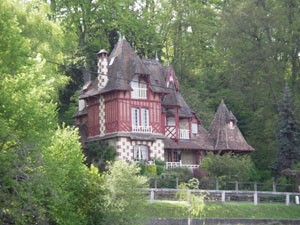 |
|
We were lucky with the locks and didn´t have to wait and could go straight in. It saved us a lot of time. Between the locks we were admiring the view and the many beautiful houses along the riverbanks. At the same time we were keeping a look out for logs and branches floating about so that we didn´t hit them. There wasn´t as much traffic as we expected. It took us two days to get to Yonne and everything went according to plan (apart from some technical problems – see below…)
|
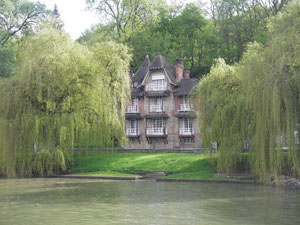 |
|
On the river Yonne there were also locks, but these had sloping sides. You had to keep yourself moored and steady somehow and when the water rose keep the boat off the sides. There was a sloping ladder on the side which we reached with our boat hook. When the water started rushing in we were really struggling to keep the boat in place. The boat hook broke. We had to stay in the middle of the lock with the help of our engine. We figured out another solution: We could use the buoy hook with a line attached to it and clip it onto the ladder.
|
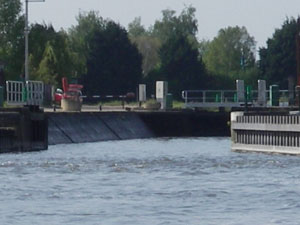 |
|
We never had any use of this idea, as the following locks had floating pontoons to tie up on! It was a brilliant idea, though….
|
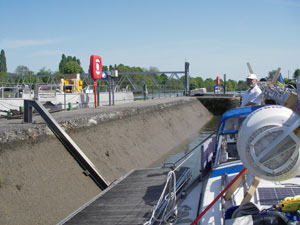 |
|
It isn´t easy to find a mooring place along a river, so we were really pleased to see this sign. It even told you the depth at the quay. It felt safe to moor there and we enjoyed a nice Sunday lunch and got ready to spend the night there. Thank you VNF!
|
|
|
The Sun had its´ hat on when we continued our travels the next day. The closeness to nature and the views were breathtaking. Nevertheless, we got hungry and stopped at Joigny for lunch. There was a Boulangerie, or Baker´s shop, just by the quay where we bought fresh bread. Couldn´t be handier.
|
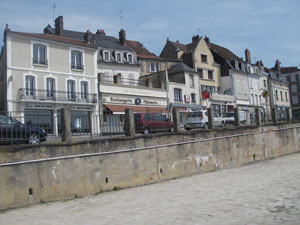 |
|
Here you see a view of Yonne.
|
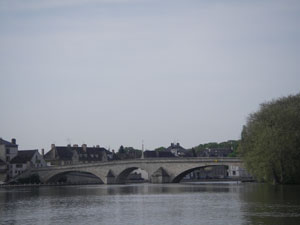 |
|
|
|
|
It took us four days to get to Migennes, which is the beginning of Canal-de-Bourgogne. The difference between a canal and a river is great, which you will find out below.
|
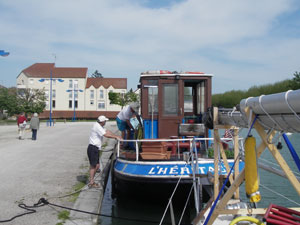 |
|
Technical mishaps |
|
|
We always check the oil, water filter and the cooling system in the engine before we leave in the mornings. We don´t need to mention our diesel consumption. But after our first night away we couldn´t get the oil stick out of the engine. It was stuck fast. We took out the whole housing for the oil stick and still we couldn´t get it out. In the end Mike drilled a hole in the screw, so that we could get in a lever made of steel. At last we got it off! We can also mention that the oil level was OK…
|
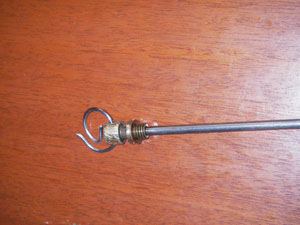 |
| Now with a metal ring | |
|
After our lovely Sunday lunch I was going to wash up as usual. This involves pumping up water into the sink using a foot pump. We said from the start that we didn´t want an electric pump, as these could cause trouble. Now I got a wet foot instead, because the rubber on the foot pump had split! When we at long last got the footpump out we could see that it was passed saving – most likely the original pump. We decided to get a new one at the earliest opportunity. We still had the possibility of pumping up water from the tank in the “heads”.
|
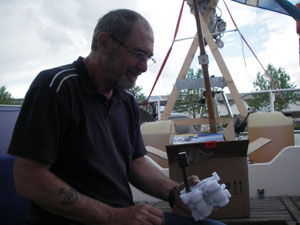 |
| The new pump has arrived! | |
|
The next day we thought we could hear water trickling and what was that awful smell? It didn´t take long to establish that it was the back valve on the toilet which wasn´t working properly. We had to disconnect the water intake at night when we couldn´t keep an eye on the toilet. More to add to our shopping list.
|
No picture needed! |
|
The next technical mishap was that the aggregate to our cool box stopped working. There wasn´t any refrigeration in the box and we had to throw out a fair amount of food. Now drastic measures were needed. By this time we had reached Migennes. We decided to order what we needed from Hjertman´s in Sweden and get a parcel sent to Montbard – Poste Restante. In comparison to French prices it was cheaper doing it this way, even including the freight costs. We were counting that it would take us 4-5 days to get to Montbard. No more mishaps – but these were quite enough!
|
Phew! |
|
A practical tip |
|
|
In Migennes we stocked up with fuel for ourselves as well as the boat. Have you noticed that when you are pouring diesel out of a can it is normally windy? The diesel is splashing everywhere apart from where it is supposed to go, i.e. in the funnel where it belongs. Mike had the following idea: Put a pipe on the airing hole with a jubilee clip and open the large top. The diesel will end up where it belongs. In the funnel we also have a filter and we have noticed dirt gathering there, so it is well worth the money. Much easier to fill up this way.
|
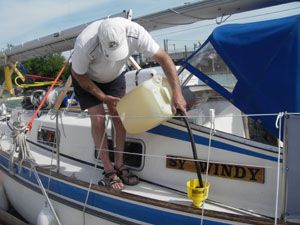 |
|
Animals and the countryside |
|
|
Every day was filled with beautiful scenery and encounters with wildlife. How many pictures can you take of a canal bank and its´ views? As many as you like! Here are a few we would like to share with you:
|
|
|
Flowers! Here we saw all the flowers of Midsummer and more. In the picture a bank full of buttercups and cowslips. It was a lovely experience going into the lock and wait for the lock to fill, so that you could see over the edge. There you would find flowers such as yellow birds foot trefoil, light blue forget-me-nots, red- and white clover, hare bells, buttercups and a lot of others I don´t know the names of. And when you got further up you had the view of fields and tree covered hills.
|
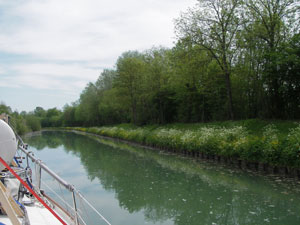 |
|
The canal was meandering between hills covered in lush trees. There were a lot of different kinds I had never seen before. I have to find out more about these… The feeling going through here was simply – tranquility.
|
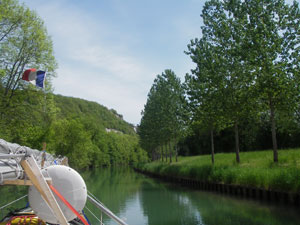 |
|
Burgundy has its´ own breed of cattle, i.e. Charolais grazing in the green fields. Competition from the mass-imported “hormone-filled zebus” is strong. At long last I had use of the one French phrase I remember from school: “The bull stands in the meadow” (I can´t spell it though!)
|
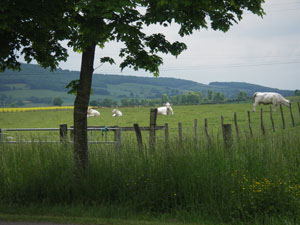 |
|
We passed a lot of farmed fields and we could see that France is a big agricultural country. With the climate here there are bound to be several crops in a year. |
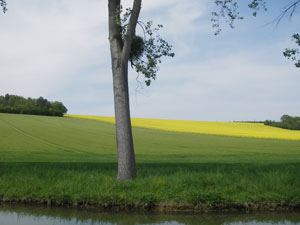 |
|
The horse has been of big importance. During the medieval times, not only as a means of transport and an instrument in warfare, but has also made it possible to increase agricultural yields. The horse was a sign of power and modernism. When the agriculture got mechanized the horse lost its´ roll as an “energy supplier”. Here we have a beauty who wonders what was chugging past in the middle of the countryside.
|
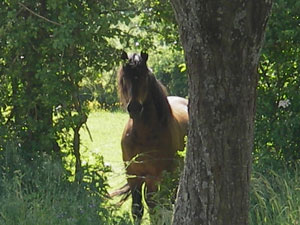 |
|
To wake up to bird song, or the “dawn chorus”, as the English say, is wonderful. Sometimes quite early in the day – but still… When you are sitting in the cockpit and reading in the evening and you can hear the blackbird, chaffinch and the cuckoo – see the house martins playing “Simon says”- and swans and ducks with their little ones swimming around – well, then it is good to be alive. Herons have also been following us along the canal. Once we saw a falcon catch a fish right in front of the boat, so heavy that it just about got to the bank…
More pictures in our archive.
|
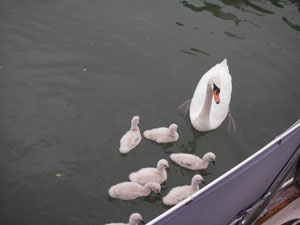 |
|
A practical tip |
|
|
Our galley isn´t very big, so it is important that it is well organized so that you find things easily. Kitchen roll is one thing. Where should you keep it? The solution was a bit of chord fastened to the box for the binoculars. It is always at hand. The spice rack Mike made in Paris. A lot better than having to look for a spice in the cupboard, where the spice you want always is furthest in. We are very happy with the solution.
|
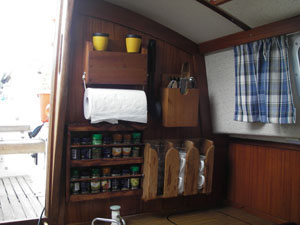 |
|
Canal de Bourgogne |
|
|
There is a big difference between traveling in a canal compared to a river. Apart from it being smaller, of course, there aren´t any strong currents. The big barges do not use these canals either. The odd Hotel Barge will use the canals, but not the big commercial ones. The tempo is completely different – nice and easy.
|
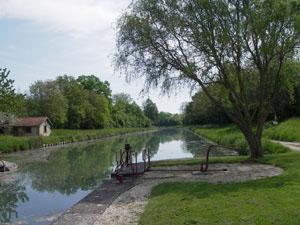 |
|
The canal has, as mentioned, 189 locks and the actual locking is done at your leisure. Most of the locks are handled manually, i.e. a lockkeeper opens and closes the gates by hand. Very nice people who are responsible for 2-3 locks respectively. Sometimes you meet a boat and have to wait, but not very often. Note the lockkeeper in the picture.
|
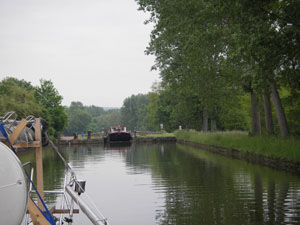 |
|
Burgundy is known for its´ trade over the centuries, where the rivers Seine, Loire, Sâone and Rhône have played a great part. To connect these rivers was an ambition already in the 16th century. This became a reality in the 18th century and 1788 the regional assembly had an obelisk erected in Dijon as a sign of “eternal” gratitude to Louis XVI. Here a picture of an old lock wall…
|
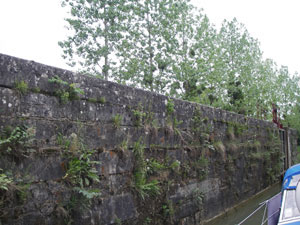 |
|
We arrived at Ancy-leFranc on the 9th May, the day after the “Victory V-day” celebrations. There are a lot of war memorials in all the towns and you get reminded about what happened. This is good if it means that it will never happen again…
|
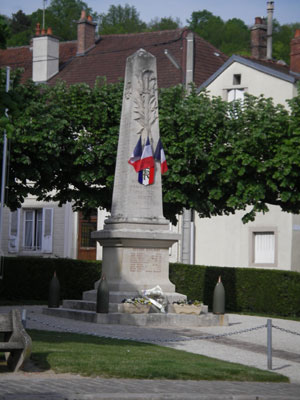 |
|
A practical tip |
|
|
We weren´t always lucky to stop at a place where there was electricity, water and showers. To maintain the security level onboard, (you think better if you are fresh, clean and content), we were very particular about hygiene. Apart from anything you smell nicer too… Here´s a picture of Mike under the shower bag, which is very practical. The water warms up in the sun and on cloudy days we boiled the kettle.
|
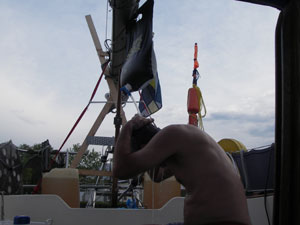 |
|
The Canal, cont´d/… |
|
|
We arrived at Montbard on the 11th May. A Sunday, and looked forward to Monday when we were going to the Post Office to see if our parcel had arrived. We didn´t count on it being a bank holiday (Whitsun) and the Post Office was closed. As it was the parcel didn´t arrive until the 17th May. During the week we were sightseeing in Montbard and worked with other maintenance on the boat. The weather was changeable and one sunny day we waxed the deck. We did all our repairs on the 17th and on the 18th we were on our way again.
|
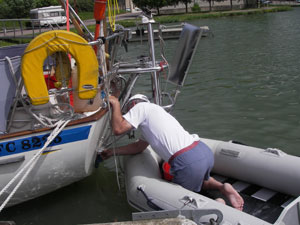 |
|
|
|
|
In our guide book “Inland Waterways of France” it says that boats with a draught of 1,80m can use this canal. Our draught is 1,40m and we got stuck several times and often scraped the bottom of the canal. Sometimes we had to moor along the canal and didn´t get close to the bank. We had to moor from afar, but there was no danger, we couldn´t get very far between the locks anyway.
|
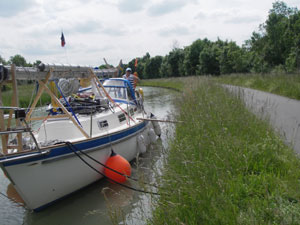 |
|
If you come from the Yonne you have 113 locks up to the plateu and after the Pouilly tunnel 76 locks down to the Sâone. It is always harder to lock upwards than down. It is difficult to reach the bollards when you are 2-3 m below them. Mike and I trained at throwing the lasso and it did actually happen that we got the line around a bollard at the first attempt! Otherwise we had a method of making a whip with the line if it landed next to the bollard. It worked well.
|
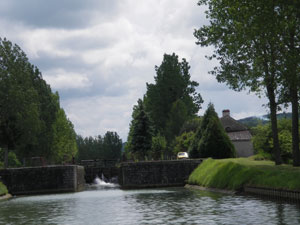 |
|
The security was very strict before we could get through the tunnel at Pouilly. They checked that we had life jackets, search lights, fire extinguisher and a signal horn on the boat and we got a walkie-talkie from the lockkeeper before we set off. The tunnel is 3337m long and has a very narrow cut before you go in.
|
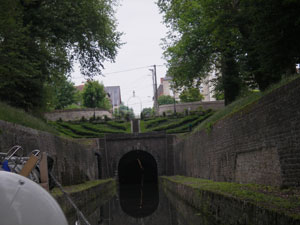 |
|
The tunnel itself wasn´t as claustrophobic as I expected. There was lighting all the way through and it was a fantastic experience. Little stalactites were hanging from the ceiling and bats were flying around. You had to duck now and again…
|
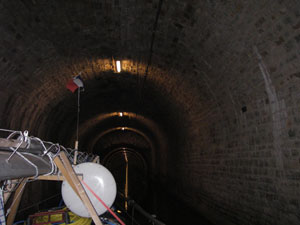 |
|
The locking downwards was so easy it felt like a holiday compared to coming up and the leg to Dijon went without any mishaps. But first we have to mention Pont-d´Ouche. The guest harbour there had everything a sailor could wish for. A pontoon to moor at, electricity and water, shower, a little shop (with English goods such as Marmite!) and books. The second floor of this little house was full of books you could exchange. We changed about a dozen books to “new” ones. The harbour master was an English lady called Bryony – very nice.
|
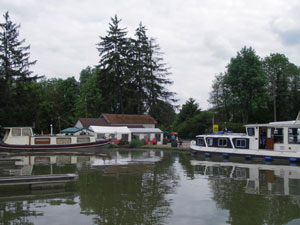 |
|
At Pont-d´Ouche there was also a little aqueduct. Very picturesque.
|
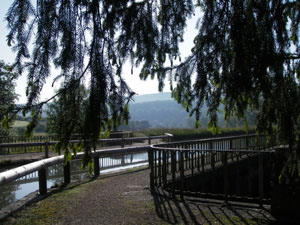 |
|
In Dijon we stayed three full days. Dijon is the capital of Burgundy and filled with history. We made our way to the “Old Town” which dates back to Roman times. A lot of narrow streets, magnificent buildings and monuments. We climbed up the 316 steps of the Tower of Philip the Good and got a scenic view of Dijon. From here you could clearly see the painted roof tiles, which are typical of Burgundy. More pictures in the gallery.
|
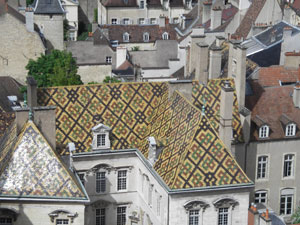 |
|
We like to visit museums and found a very interesting one depicting life in Burgundy through the centuries. We walked around for a couple of hours imagining what it was like to live here then. |
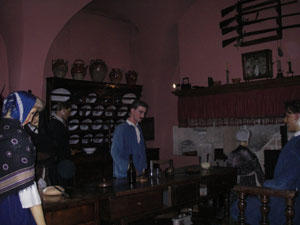 |
|
Apart from having cleaned the boat inside and out and paid a few bills (!) it felt good to have acquired some knowledge about the area we were in.
|
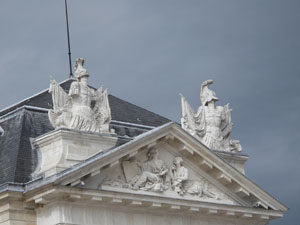 |
|
The 28th May we continued our journey. The locking didn´t give us any problems at all during the way to St. Jean-de-Losne, which is the last stop on the canal. Between Dijon and St. Jean-de-Losne we stopped along the bank for a night. During the night the water level had sunk and we were quite stuck in the mud. No matter how we tried we couldn´t get off.
|
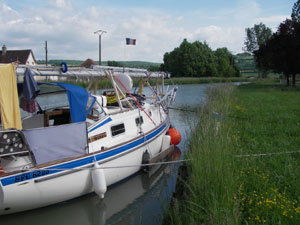 |
|
We weren´t far from a bridge, so Mike went over to the other side of the canal to throw a line over to the boat. Perhaps we could pull the boat off from the other side? (A commercial quay) The line was too heavy – it didn´t reach all the way to the boat. What to do now? (Now it was raining quite heavily too – of course). We took our life line, which has a weight at the other end, and used it as a heaving line. It got over to the other side – we tied our mooring line to it and pulled it across to the boat. Then we winched the boat off. Hard work – but it worked!
|
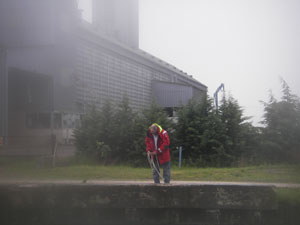 |
|
In St. Jean-de-Losne we stocked up with diesel and fresh fruit before our next leg on the river Sâone. We were pondering whether we would do the canal again. In spite of all the locks it was well worth the effort to get up to the plateau. An incredible experience where you got close to people as well as the countryside. It would be easier with a boat without a keel…
|
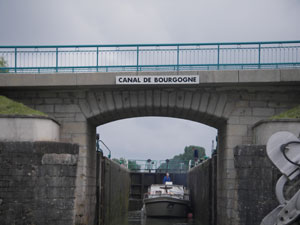 |
|
A practical tip |
|
|
On a boat, as well as anywhere else, you always need rags for all sorts of things. I realized that old socks are the perfect thing. Just cut them open and voila! Size 10 can be recommended.
|
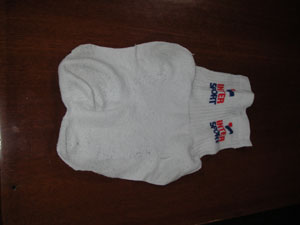 |
|
The rivers Saône and Rhône |
|
|
It was a lovely feeling to get out onto the river! More space and more speed – we got up to 7 knots straight away. Now we were also traveling downstream. We soon realized that we needed a “log-watch” as there were a lot of logs, sticks and branches floating around. We definitely didn´t want to get these into the propeller or damage the boat in any way.
|
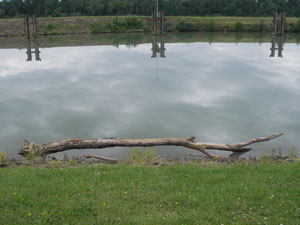 |
|
We got to Chalon-sur-Saône in six hours and had traveled 59 km. On the canal we covered a distance of about 12 km/day. We went through two locks that were very big, but were no problem. These were going down as well.
|
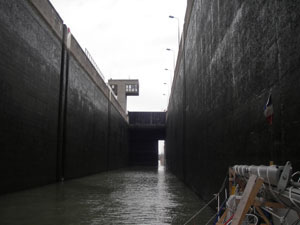 |
|
A nice flower arrangement welcomed us to Ile Saint Laurent, where the guest harbour is. The harbour was very nice and modern with all services. Noticed that it was an EU-project. Money well spent!
|
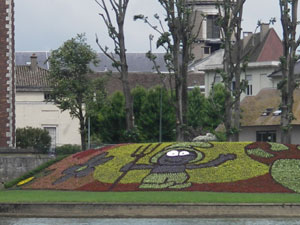 |
|
Chalon is also a medieval town that is very picturesque. The town has been and is a centre for trade. Naturally wine in this winedistrict, cloth and earlier hides.
|
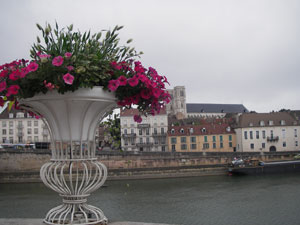 |
|
Nicéphore Niepce came from here as well and was the man who invented photography. We are happy about that today.
|
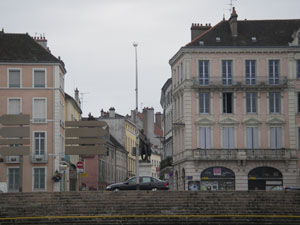 |
|
We visited a wine cellar and got a mini lesson in white wines, which we prefer. We found out that all the white wines from Burgundy are of the type Chardonnay – apart from the Aligoté. Our rucksack was not empty when we left…
|
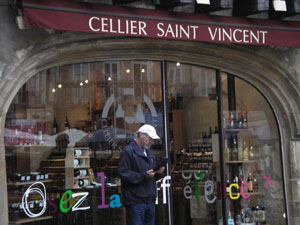 |
|
There were plenty of fishermen on the pontoons in the harbour and one of them caught this fish. It is called a “celure” in French and is a type of cat fish. It is a scavenger and eats anything. It can get very big – even up to 100kg, we were told. There are a lot of them in the river and they apparently destroy the marine life. So the opinion is that it is good when they are caught.
|
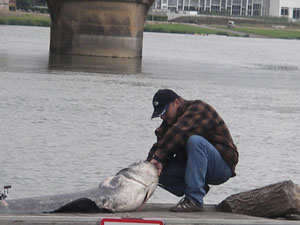 |
|
On the 1st June we left with our goal being Macon. We didn´t get further than the lock Orme, 23 km down river. It was 10.45 when we tied up at the floating pontoon just before the lock. And we didn´t get any further that day due to technical problems on the lock gates. Before evening we were five boats moored there; two Danes, two Dutch and us. During our travels to Avignon we met up with these boats in various places and greeted each other as long lost friends.
|
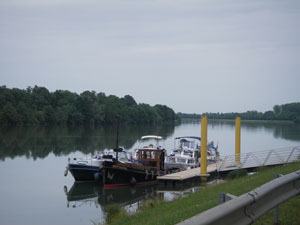 |
|
The next day we got away at 10.45, exactly 24 hours later. A French sailing boat joined us in the lock. When we got out of the lock it looked like an armada of boats.
|
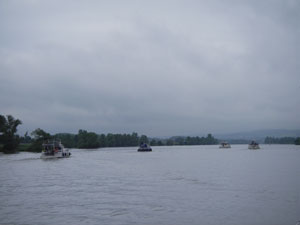 |
|
This sailing boat, Dream of Baladin, we met several times. They didn´t speak any English and we no French to speak of, but we understood each other quite well anyway. In one of the locks they got rammed by a pleasure boat, looking like a small barge. It could have been really bad. As it was the man got injured trying to save his boat. The boat got a hole in it, but luckily over the water line. We were lucky – it only just missed us. This might have been the end of our dream…
|
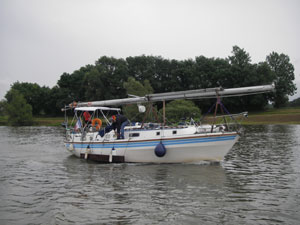 |
|
We had just got into Macon when the storm broke out. We stayed only one night here and carried on the next day. We didn´t visit the community.
|
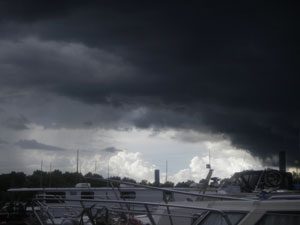 |
|
We glimpsed Lyon around the corner and decided not to stop there. The mooring places didn´t look that safe. As we passed, the boats moored there were bobbing about in the current. The town itself looked very interesting with a lot of spectacular buildings. Lyon is big, it took us at least an hour to get through.
|
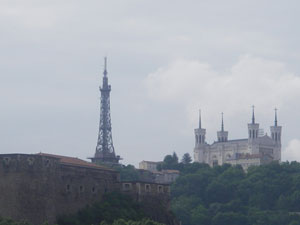 |
|
We expected the river to get very big when Saône and Rhône merged and we were not disappointed. We felt quite small in the vastness. We also expected more commercial traffic, but there wasn´t as much as we thought.
|
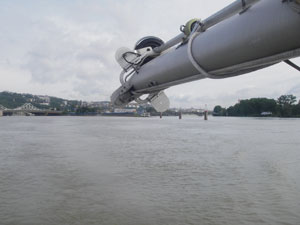 |
|
The locks, on the other hand, are very much bigger with a fall of 18 – 26 metres. We were pleased to find floating bollards we could tie on to and just follow them down. The largest lock was called Bollene with a fall of 26 metres. We had to circle a fair deal before we could enter the lock, as there were a few commercial barges which had the right of way. The prevailing wind Mistral started to increase in strength and later we found out that this time it “only” blew 80 km/hour. Our new boat hook flew away!
|
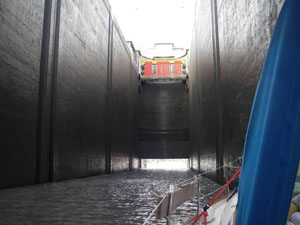 |
|
There weren´t many places to moor along the river, so we made our way to the few guest harbours there were. They varied a lot in price, from €5 - €21 per night. Viviers had a middling price at €13 with a nice little village and a big castle. We found an English daily paper here – the first one since Paris.
|
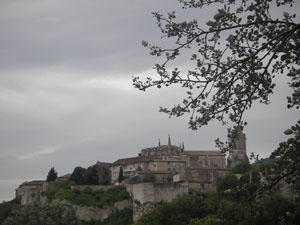 |
|
Along the Rhône there were different kinds of power plants. By every lock there was a hydro plant. We have also passed several nuclear power stations. The windmills were also whirring, but not that many. Which source is the best one for humanity? In the picture a nuclear power station with a windmill in front of it.
|
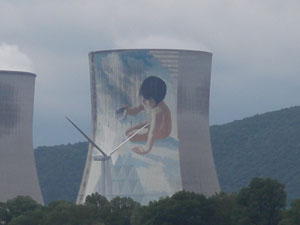 |
|
The current on the Rhône is very strong. We reached 10,3 knots and have never traveled that fast in our boat! When we were circling and went upstream we were down to 3 knots. We saw several boats struggling on their way up. No wonder that the river is closed for pleasure boats in the spring! What we also noticed is that the water is grey-black in colour. We have been discussing what is causing this but have not reached any conclusion. (Mike thinks it is mud)
|
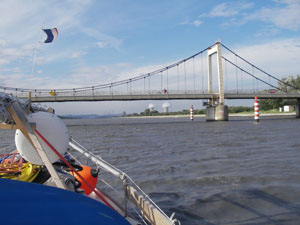 |
|
Now we were looking forward to reaching Avignon, where we planned to stay for a while. A lot of practical things to sort out, writing on the web and also do a bit of sightseeing in Avignon. The first sight of Avignon was the gold coloured statue on the Basilica Notre-Dame. An impressive sight.
|
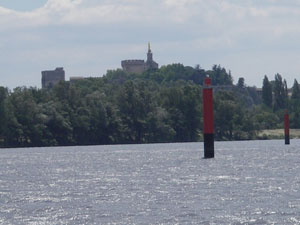 |
|
Avignon is situated where the rivers Durance and Rhône merge and where there also is a big rock. We made our way into the centre and moored just by the battlements around the town and behind the St. Benezet bridge.
|
 |
|
Avignon is a very old town dating back to the stone age. It is said that the Cavari people named the place Aouenion, from Celtic or Ligurian words meaning “town of violent wind” or “lord of the waters”. There is a Greek and a Roman period. Even a “barbarian” period. The history is very interesting and exciting. One distinguishing fact is that Avignon was the capital of Christendom during the 14th century. Seven Popes resided here during that time.
|
 |
|
When we got here we saw several boats we had seen earlier; “Fulton” from Denmark, “Dream of Baladin” och “Heide” also from Denmark. A Swedish boat has just arrived on its´ way home.
|
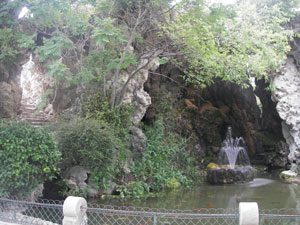 |
| Dom Rock | |
|
Now we are looking forward to the last leg before we reach the Mediterranean and Port St. Louis. There certainly are some butterflies in the stomach to have reached this far, but it will be nice to get the mast up again.
|
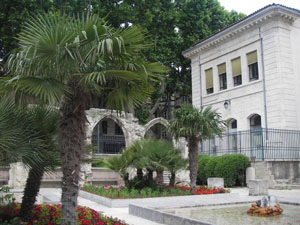 |
| Avignon - Park | |
|
A practical tip: |
|
|
I have got a new hair colour! This colour is quite fantastic – when it grows the roots are the same colour as the rest of the hair. Not bad at all! And you save a lot of money.
|
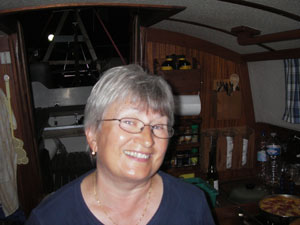 |
|
We wish you all a nice time till we get in touch again - from somewhere in the Mediterranean. |
|
